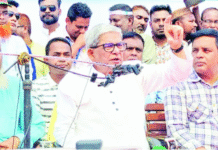
Protesters carry dummies of fish, tiger, beer and tree; all are the inhabitants of the largest mangrove forest of the country the Sundarbans, during the launching of a long march in the capital’s Press Club on Tuesday demanding scrapping of a Power Plant project near in Rampal, Bagerhat.
Hundreds of people left the capital Tuesday morning with a long march demanding scrapping of the Rampal Power Plant project.
The National Committee to Protect Oil, Gas, Mineral Resources, Power and Ports, organiser of the demonstration, plans to go to the project site in Rampal, Bagerhat.
Initially, over 1,200 people from different walks of life took part in the demonstration, which began around 11:00am after a rally at the Jatiya Press Club.
From the JPC, the long march moved towards Asad Gate via Shahbagh and Dhanmondi.
A convoy of buses carrying the protesters set off for Rampal from Asad gate.
The long march is scheduled to reach Rampal, which is only 14 kilometres away from the Sundarbans, on Saturday.
The long march is the consequence of public fear that if the power plant is implemented, it would destroy the world’s largest mangrove forest.

Hundreds of people leave Dhaka Tuesday morning with a long march demanding scrapping of a Power Plant project near the Sundarbans in Rampal, Bagerhat. The photo is taken from the road near Ramna Park in the capital.
On April 20 this year, Bangladesh and India inked a deal to construct a 1,320MW coal-fired power plant in Bagerhat’s Rampal area.
“I urge the government to find alternative solutions to generate energy without destroying the Sundarbans,” said Prof Anu Mohammad, member secretary of the committee, before the beginning of the long march.
The committee in association with a number of left parties including Communist Party of Bangladesh (CPB), Bangladesher Samajtantrik Dal (BSD) and Gono Sanghati Andolon organised the rally at 10:00am.
As part of its schedule, the participants held a roadside rally in front of the RanaPlaza site in Savar where the nine-storey building collapsed on April 24, killing at least 1,133 people.
During a 30-minute rally that started around 1:30pm, the participants of the long march commemorated the victims of Rana Plaza.
They left the Rana Plaza site around 2:00pm for Manikganj where they are scheduled to hold another rally.
During their march towards Rampal, the protesters are also scheduled to hold rallies at Faridpur, Jessore and Khulna.
The march will end with a rally at Digraj in Rampal upazila on September 28.
The Rampal project drew huge flak from eminent citizens including the national committee members as they alleged that in the name of solving the energy crisis, the government has taken a destructive path to serve the interests of a vested quarter at home and abroad.
Source: The Daily Star










Regarding the government decision to construct the Rampal coal power plant in Bangladesh, I am surprised why the people who have technical knowledge about the air, water and land pollution from such plants did not object strongly at the early stages of the decision-making process. Not only near the Sunderbans, but nowhere else in Bangladesh, any coal-fired power plant is acceptable. It would be much better option for us to import power than to construct coal plants. As an environmental engineer, and with power plant pollution-related experience, I would say that for a densely populated country such as Bangladesh, we can afford to construct only renewable fuel-based projects, should we decide to protect public health and the environment. In future, under any government, people of Bangladesh should resist the construction of any type of polluting projects in Bangladesh, be it power plant or any other type of plant. Ours is an agrarian-based country, and we should leave it that way.